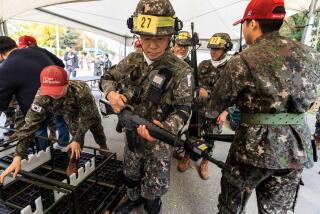Teamwork Counts Most When in the Military : CAMPUS CORRESPONDENCE
WEST POINT, N.Y. — It seems as if every interest group in Washington has an agenda for the composition of the armed forces. Some want more diversity; others complain that the military should not be an incubator for social experimentation. Both views are wrong.
Ethnicity, sexual orientation or gender is not important to the armed forces’ central mission: defending the United States. What is important is the ability to work together as a team.
Consider a view of West Point rarely seen, one far from regimental parades. It is a cold October afternoon. Inside Arvin gymnasium, seniors are preparing to run their final indoor obstacle course. The obstacles are old and complicated: a low-crawl across the floor; a vault; a shelf 6 feet above the ground; a wall; various monkey bars, and several ropes attached to a track one story above. Underclass cadets fill the bleachers. Dressed in their standard gym uniforms waiting nervously to begin the run are men and women, skinny cadets and stocky ones, short seniors and tall ones.
Although certainly an individual test, the obstacle course is also a class challenge. Every cadet who passes does so the same way--drawing on practice, support and motivation. Overcoming obstacles and attacking a problem are what the military is all about. You do a job together that you would never finish on your own. Everyone on the team must focus on winning and looking out for each other. Individuals coalesce into a unit.
In short, it is not what you are when you enter the academy; it is what you become as a component of the team.
In the army, lives depend on individuals coming together as a fighting force. The individual qualities and abilities that enable this transformation have nothing to do with sexual orientation, gender or ethnic background. As long as an individual commits to shouldering the rules, of becoming secondary to the mission, cohesiveness will not be destroyed.
Creating soldiers--and leaders--takes a different sort of training. At the academy, the goal is to educate and train cadets about bias and prejudice, because they work against our mission. We have some problems. More than 4,000 people from different backgrounds will not all act or think the same way. But we face up to our problems.
My experiences as a woman cadet are instructive. I could not finish a three-hour road march without a buddy to talk to and, more often than not, that buddy is a man. True, we are a competitive school, which causes some problems when the men wonder why women do more sit-ups but fewer pushups on our biannual test. But I see this tension as a good sign, an indicator that progress is being made. In the classroom and in training, where it counts, we compete equally.
I’m not a policy advocate, nor do I speak for anyone but myself. My mission as a soon-to-be army officer is to support and execute. President Bill Clinton may order personnel changes that will affect military service. That is of secondary importance to me, however.
Just as I’ve shared the agony of overcoming the indoor obstacles in Arvin gymnasium with all 1,027 of my classmates, I will serve proudly with anyone who shares the desire I’ve discovered: It is better to share tough times with good people than to party with bad characters.


